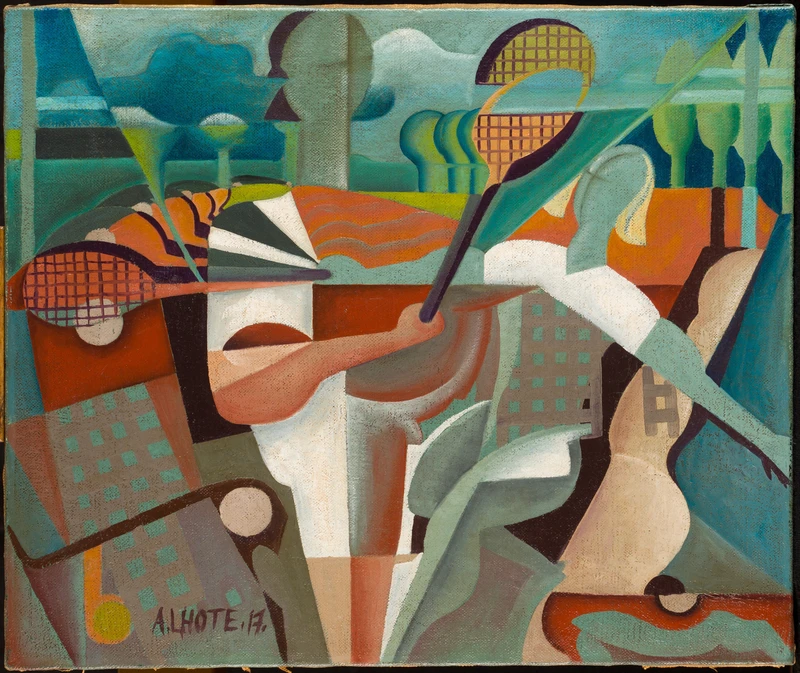Paris 1924: Sport, Art and the Body
19 Jul-3 Nov 2024


This summer, the Olympics will return to Paris for the first time in a century. The 1924 Olympics were the first truly international Games, taking place at a turning point in the histories of both sport and art. A major new exhibition at the Fitzwilliam Museum in Cambridge, Paris 1924: Sport, Art and the Body, will look back on this pivotal moment when traditions and trailblazers collided, fusing the Olympics’ classical legacy with the European avant-garde spirit.
This diverse and unprecedented exhibition will reveal how international artists working across different disciplines – including prominent modernist artists such as Pablo Picasso, Diego Rivera, Natalia Gontcharova and Umberto Boccioni – were all engaged with themes of the sporting body. It will present these works of art in dialogue with classical sculpture, posters, fashion, film, photography, sporting objects, advertising and more, to demonstrate how sport captured the imagination of visual culture across different forms. In turn, Paris 1924: Sport, Art and the Body will illuminate how the 1924 Olympics were a breakthrough that dramatically changed attitudes towards sporting achievement and celebrity, as well as body image and identity, class, race and gender.
The 1924 Olympics were inspired by the original games of ancient Greece, yet wholly in step with the changing times. The 'Roaring Twenties’ saw dramatic technological, social and economic development: the 1924 Games were the first to broadcast radio commentaries on events, and advances in training, clothing and equipment helped athletes break new records. Unprecedented media coverage of the Olympics made athletes into icons unlike never before. This exhibition will investigate the tensions and dialogues between the Games’ classical beginnings and the explosion of modernity, revealing how the Paris 1924 Olympics were shaped by the visual culture of the period, and how in turn the arts were shaped by them.
Paris 1924 will spotlight some of the breakout stars who triumphed at the Games, revealing how they became immortalised in formal portraits and more popular material. It will tell the stories of athletes such as the sprinter and Cambridge University alum Harold Abrahams, whose story inspired the award-winning film ‘Chariots of Fire’, as well as American long jumper William DeHart Hubbard who became the first Black person to win an Olympic gold medal in an individual event. Among the rare loans to the exhibition will be the letter sent by Hubbard to his mother from the SS America en route to the Olympics, in which he prophetically declared his intention of becoming the first ‘colored Olympic champion’.
As technological and scientific advancements in the early 1900s helped athletes smash records, artists too reimagined the relationship of man and machine. Among the highlights of the exhibition will be modernist artworks such as Robert Delaunay’s The Runners 1924, Gino Severini’s Dancer No. 5 1915/16 and Andre Lhote’s Tennis Players 1917, all of which reveal the radical new ways in which early 20th-century artists chose to depict sport and the body.
From 1912-1948, the Olympics incorporated Arts Competitions, inspired by the contests in music, dance, theatre and athletics that were a defining feature of public festivals in ancient Greece. The exhibition will look at this little-known part of Olympic history, bringing together some of the winning entries in painting and sculpture which ran alongside the sporting competition.
The new phenomenon of broadcasting international sport presented a dramatically different image of the male and female body to unprecedented audiences. The parading of male bodies projected hyper-masculinity to the world, while the new representation of women as physically strong and assertive spoke to the contemporaneous women’s suffrage movement. The flip-side, however, was that the widespread dissemination of photographs and the dawn of commercial cinema helped to transform these men and women into sex-symbols. Artworks such as Alexander Calder’s wire sculpture Helen Wills (1927) and Marsden Hartley’s The Strong Man (c.1923), reveal how athletes became objects of the gaze, and how the sporting body helped perpetuate as well as challenge attitudes towards sex.
Like no other Olympics before, Paris 1924 thrust its athletes and their merchandise into the spotlight. The exhibition will showcase how the Olympians became celebrities in their own right, helping to sell high end Paris fashion, endorsing athletics brands and making personal appearances, writing books and doing tours. Swimming superstar Johnny Weissmuller went on to become a Hollywood icon after winning gold at the Paris Games, and American tennis player Helen Wills became the first female athlete to become a global celebrity. This final section of the exhibition will look at the commercialisation of the 1924 Olympics which had a dramatic effect on how sport was perceived and continues to shape the way in which sport is seen today, a century on.
Paris 1924: Sport, Art and the Body is curated by Caroline Vout, Professor of Classics and Director of the Museum of Classical Archaeology at the University of Cambridge, and Christopher Young, Head of the School of Arts and Humanities and Professor of Modern and Medieval German studies at the University of Cambridge.